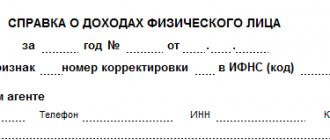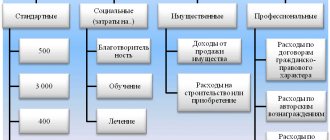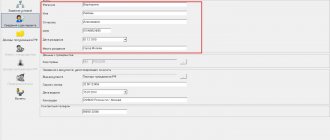The legislation regulates certain types of income of citizens, which are deducted from the total amount for taxation. Tax deductions are not subject to the usual personal income tax rate of 13% if they are standard.
Amounts deducted for children are standard tax deductions. This means that this form of reducing the tax burden will be in effect continuously as long as the original status of the taxpayer is maintained (in this case, receiving taxable income and the presence of one or more future heirs).
To whom can this deduction be made?
Article 218 of the Tax Code of the Russian Federation prescribes the procedure for assigning and calculating tax benefits, including “children’s” deductions. According to the law, the child tax deduction is an amount of money designated in regulations, from which the 13% personal income tax (income tax) will not be charged.
Each has the right to make this deduction :
- the child's natural parents;
- adoptive parents;
- guardians;
- trustees.
The right to receive this tax benefit is recognized if there are one or more offspring under the age of 18 or older (up to 24 years), if the eldest child is a full-time student as:
- student;
- cadet;
- intern;
- graduate student;
- resident.
FOR YOUR INFORMATION! Full-time education is allowed not only in an educational institution in the Russian Federation, but also abroad. Studying a master's degree as a first higher education will not be an obstacle to assigning a tax deduction (naturally, if the child meets the age criterion).
Regardless of age, a separate tax deduction will be accrued for disabled children.
Results
Standard deductions, each of which has its own specific amount, are divided into 2 types:
- Personal, without restrictions on the period and amount of income, provided to persons who have special merits to the state;
- Children's benefits given to children up to a certain age and within the limited income of the applicant for a deduction, the right to which arises from parents, adoptive parents, guardians, trustees, adoptive parents, and their spouses.
The amount of the child deduction depends on the child’s priority and whether he or she has a disability. In the latter case, who exactly the recipient of the deduction is to the child also plays a role.
To receive each type of deduction, the employer submits a separate free-form application, accompanied by documents confirming the right to provide a deduction of one size or another.
Sources: Tax Code of the Russian Federation
You can find more complete information on the topic in ConsultantPlus. Free trial access to the system for 2 days.
First, second, third... How much do we subtract?
The tax deduction is assigned separately for each child who meets the age criteria. For a child born first or second, it is the same amount, namely 1,400 rubles. If the taxpayer is in the care of three or more children or older children eligible for deduction, then for each offspring younger than the second, a deduction in the amount of 3,000 rubles will be charged. The amounts allocated for each of them are added up.
The number of children is counted according to seniority, that is, in the chronological order of their birth. In this case, the age of the older children and their status are not important. For example, the oldest is already over 18 and is not a full-time student, that is, he is not subject to a tax deduction, and there are only three children in the family. In this case, the youngest, who has not reached this age, is still the third child, who is entitled to a deduction in a larger amount - 3,000 rubles.
IMPORTANT! In tragic cases of death of children, their number according to seniority does not change: every living child still continues to be considered the same in number as he was at the moment of birth. If spouses have new children in another marriage, they will no longer be considered the first: the chronological order of birth is preserved.
A disabled child has the right to make a deduction within the following limits:
- 12,000 for each of the parents (natural or adopted);
- 6,000 (for guardians and trustees).
NOTE! The amounts given are not the money that will be returned to the taxpayer with children. These funds simply will not be charged the additional 13% due to personal income tax. For example, a citizen with two minor children will receive a tax benefit (1400 + 1400) x 0.13 = 364 rubles. This amount will make his tax burden lighter.
Users of the official website of the Federal Tax Service have the opportunity to independently calculate tax deductions using the online service. To calculate, you will need to enter the initial data in special fields:
- amount of children;
- the amount of taxable income for the previous period;
- data regarding children with disabilities.
How much can you return?
The Tax Code of the Russian Federation provides for several types of tax deductions. Among them are standard ones, provided in connection with a certain citizen status or marital status. The benefit can be used by parents, adoptive parents, guardians and trustees.
The amount depends on the number of children, their state of health, whether the taxpayer is raising them alone or married, and who the minor child is: a parent or guardian. In 2021, the following tax benefits have been established:
- 1,400 rubles each for the first and second child;
- 3,000 rubles each for the third and subsequent ones;
- 12,000 rubles for a disabled person, if the taxpayer is his blood parent or official adoptive parent;
- 6,000 rubles - for a disabled person, if the taxpayer is his guardian or trustee.
The benefits are summed up, for example, if a citizen has three minor descendants, he will receive 1,400 rubles for the first and second, 3,000 rubles for the third, the amount of compensation will be 5,800 rubles.
IMPORTANT!
Single parents receive double benefits!
Double deduction amount
The law gives the right to certain categories of citizens to make a “children’s” tax deduction, doubled. If a child is being raised by a single mother, she has this right unconditionally (just like a father raising a child alone). Any parent can refuse to receive the child deduction due to him, then his share of this tax benefit will go to the other parent. If the child is adopted, then if one of the adoptive parents refuses the deduction, the other will receive it double.
When there is only one parent
There is no term “sole parent” in legislative acts. A single mother (less often a father) is considered the only parent by law if this is proven in the following documents:
- the second parent is not listed on the child’s birth certificate;
- The registry office issued a certificate (form 25) that information about the second parent was recorded in the certificate from the words of the first (most often the father is entered from the words of the mother);
- the second parent has died, for which there is official medical evidence;
- the second parent is officially deprived of parental rights;
- there is a court decision declaring the second parent dead or missing.
ATTENTION! An unregistered marriage cannot be grounds for recognizing a parent as single.
If a single parent registered a marriage, he will no longer be entitled to receive a double tax deduction, since he is no longer the sole caregiver of his child. But the new spouse automatically acquires the right to this benefit.
Engine depowering to reduce tax: ways to reduce power
Many car owners who want to reduce their vehicle tax payments are wondering whether it is realistic to reduce engine power. There are several legal ways to depower an engine:
- In case of incorrect data in the vehicle passport (PTS). To correct the situation, you need to contact the company’s dealer with a request to provide a certificate of the actual engine power, and then contact the traffic police department to make changes to the document;
- When completely replacing the motor. Before depowering a vehicle’s engine, it is necessary to find a certified workshop that will not only replace the unit, but also issue an appropriate conclusion. After passing a special examination, you must bring the conclusion to the traffic police and correct the data;
- Aggregate depowering is only possible with vehicles that are already registered with the traffic police. To do this, you need to contact the authority with a request to depower the engine, providing all documentation on the vehicle. If the traffic police gives permission to carry out such work, it must be carried out by a certified master. After passing the MOT and receiving a diagnostic card, you must contact the traffic police with a request to make changes to the PTS.
The limit set for income when calculating deductions
A large income removes from citizens the right to tax benefits for having children. If the amount of a citizen’s income exceeds that established by the state, he himself has the financial ability to be responsible for providing for the child, so there is no reason to reduce his tax burden. Until 2021, citizens who received more than 280 thousand rubles were not able to apply for a child tax deduction. In 2021, this amount was changed, and today it is 350 thousand rubles.
The time for which the income received is calculated begins to be taken into account from the beginning of the tax period, namely the calendar year. As soon as the accrual amount in a particular month has reached the legal limit, the deduction will no longer be accrued for subsequent months.
Application for a reduction in transport tax by the amount of fees in "Platon"
Owners of vehicles weighing more than 12 tons who make payments to the Platon system can count on a reduction in transport tax if:
- the amount of fees in “Platon” is equal to or higher than the transport tax - in this case, the latter is not paid at all;
- the amount of fees in Platon is less than the tax - the owner of the vehicle pays the difference.
To receive a tax benefit, an entrepreneur must provide the following documents to the inspectorate:
- statement;
- information about the owner of the vehicle;
- documents confirming payment of the fee, in the form of a report;
- report on vehicles weighing more than 12 tons.
To write the appropriate application, it is best to use the form available at the regional tax office. It should be remembered that when filling out you will have to indicate passport data, TIN, address and telephone number, vehicle details and the reason for providing the benefit.
Documents for child tax deduction
If the child’s parents are officially employed, then their employer himself submits the necessary papers to the relevant tax authority. Citizens will simply receive wages in accordance with all taxes withheld and deductions made. The necessary documents are provided by employees to the human resources department or accounting department at their place of work.
For a standard “children’s” tax deduction you will need:
- birth or adoption certificates (for all children);
- an application in which the employee requests a standard tax deduction for the child(ren);
- certificate 2-NDFL for the previous year (if the place of work was changed);
- for children who are already 18 years old - a certificate stating that they are actually studying full-time at a particular educational institution (this certificate must be updated annually).
ADDITIONALLY! If the parents are divorced or their marriage has not been registered, then the second parent can receive a deduction if he documents that he is involved in providing for his offspring: for this he needs to provide an agreement on the payment of alimony or a certificate of registration at the same place of residence as the child. A court decision on determining the person with whom the child remains in the event of a parental divorce is also valid.
For a “double” deduction, the following is added to these documents:
- application for a double tax deduction;
- written refusal of the other parent or adoptive parent;
- Certificate 2-NDFL of the parent who wrote the refusal (for each month for which the deduction is made).
What to do if the deduction is not received on time
If for some reason an employee does not take advantage of the deductions in a timely manner, even after dismissal, he can contact the employer with an application for recalculation and refund of tax (clause 1 of Article 231 of the Tax Code of the Russian Federation) or write a similar application to the Federal Tax Service (clause 4 of Article 218 and paragraph 6 of Article 78 of the Tax Code of the Russian Federation). In the latter case, in addition to the supporting documents, you will also have to submit a 3-NDFL declaration with 2-NDFL certificates from all places of work for the required year (or years).
Read more about personal income tax refunds in the article “Procedure for income tax (NDFL) refunds: nuances .
Taxpayer liability
The employer assumes all obligations for submitting documents to the tax office, calculating and accruing due payments, including tax deductions. This obligation is provided for by the function of a tax agent that the employer performs in relation to employees.
But the employer carries out all its actions based on information and documents received directly from the employee. If the employer fulfilled his duties in good faith, and then it turned out that the employee provided false data and/or fictitious documents, liability for such an act (and sometimes criminal liability) will fall on the taxpayer himself - the hired employee, and not his employer.
What is the deadline for submitting an application?
The employer must provide the deduction to the employee after he has completed the required application. Usually, this happens when the person starts working in the organization. If the employee has not provided the necessary documents, then the employer, on his own initiative, does not have the right to establish a child deduction for him.
But a situation may arise in which the employee did not provide the deduction documents immediately, but much later. For example, in 2-3 months or by the end of the year. In this case, the benefit should be provided not from the moment of transfer of supporting documents, but from the beginning of the reporting year (or work in the company, if it began in the same year). This position is adhered to by the Ministry of Finance in its letter dated April 18, 2012 No. 03-04-06/8-118. In this case, the tax from the beginning of the period must be recalculated.
If an employee provides documents in the next calendar year, then he has the right to return the tax for the missed period independently, collecting the necessary package of documents and submitting it to the tax office along with the 3-NDFL declaration.
Attention! There is no need to write an application annually if the following conditions are met. Initially, the Tax Code does not contain such a requirement. But if the form indicated a specific year during which it is necessary to issue a deduction, then after its expiration this document will need to be submitted again.
In addition, you will need to fill out applications again if changes have been made to the Tax Code, and as a result the amount of the deduction has changed. Since the application usually indicates the amount for each child, it will be necessary to rewrite it taking into account the changes that have occurred.
You might be interested in:
Regulations on remuneration of workers: what should contain, how to draw up, approve
From what time is the deduction calculated?
The calculation period is considered to be a calendar year, so the tax benefit regarding the income tax deduction for children will be accrued from the beginning of the year. This does not take into account exactly what month the application, declaration and the rest of the documents were submitted to the tax authority.
2017 made some adjustments: now the beginning of the year for calculating deductions will be counted from the month in which the child was born, or from the day when he was adopted or guardianship was established. If an employee who has children is employed while already having them, the new employer will begin to count the required benefits starting from the month of employment, taking into account the income received directly at the new place.
How to reduce payroll tax
To reduce personal income tax, an employee can take advantage of one of the tax deductions.
This is the amount by which the state allows the income tax base to be reduced. When you use the deduction, you will either be refunded part of the tax withheld from the budget, or the employer will stop withholding personal income tax from your income until you have exhausted the entire amount of the deduction. There are several types of deductions that can help you save on income taxes:
- standard - for liquidators of the disaster at the Chernobyl nuclear power plant, heroes of the Soviet Union and heroes of the Russian Federation, participants of the Second World War, disabled people since childhood, deduction for children, and so on (Article 218 of the Tax Code of the Russian Federation);
- social - for expenses on charity, training, treatment and purchase of medicines, on non-state pension insurance, on the funded part of the labor pension (Article 219 of the Tax Code of the Russian Federation);
- investment - for persons who have an individual investment account and work with securities (Article 219.1 of the Tax Code of the Russian Federation);
- property - deductions when buying housing and selling property (Article 220 of the Tax Code of the Russian Federation);
- professional - deductions for the income of individual entrepreneurs, notaries, lawyers, royalties, income under GPC agreements, and so on (Article 221 of the Tax Code of the Russian Federation);
- deductions when carrying forward losses from transactions with securities - for those who work with securities and derivatives instruments (Article 220.1 of the Tax Code of the Russian Federation).
Tax deductions are used for different life situations. We bought an apartment - a property deduction, invested part of the funds in shares - an investment deduction, and so on.
Working parents can reduce their personal income tax using standard and social deductions.
Didn't receive the required deduction?
It happens that a taxpayer, for one reason or another, during the year did not receive the tax benefit due to him for his children. Or maybe this deduction was not fully accrued to him: tax agents also make mistakes. This does not mean at all that the possibility of deduction is lost for him.
In the coming year, he has the opportunity to return part of the amount in the amount of a deduction from the tax already paid.
The main thing is to timely submit your tax return and the required documents for a personal income tax refund:
- birth or adoption certificate (copies) for each child;
- Form 3-NDFL (declaration);
- for a son or daughter from 18 to 24 years old - a certificate of in-patient education.
Structure
The application is written in free form addressed to the head of the company - on a computer or by hand and consists of 4 parts.
A cap
. Indicated by the name of whom and from whom it is composed:
- manager position;
- Company name;
- Full name of the head;
- the position is written from;
- surname, first name, patronymic of the applicant.
Main text
. In the text, write down your request for a tax benefit:
- the basis for granting the deduction;
- sum;
- Child's full name and year of birth;
- month from which the benefit is provided (in some cases);
Applications
. In the attachments, please indicate all supporting documents that are attached to the application.
Conclusion
. At the bottom, write the date of completion, sign and indicate the transcript of the signature.
Depending on the situation of the benefit recipient, the main text in the application and which documents to attach will differ. The header and conclusion are filled out equally in all cases.
Final deadlines for deductions
If a child turns 18 this year and is not in full-time education, the standard tax deduction will be due until the end of that calendar year (month of birth does not matter).
A full-time student under 24 years of age will give the right to a deduction to his parents for the following period:
- until he graduates from educational institution (even if he is not yet 24 years old);
- until the year of your 24th birthday (even if training is not completed).
NOTE! In the tragic event of the death of a child, the reduced tax rate remains with the parents until the end of the calendar year.
conclusions
Employed parents whose children have not reached the age of majority can apply for a personal income tax deduction for children.
An exception to this rule is a situation in which a child is studying at a university on a full-time basis. In this case, the deduction is provided up to 24 years.
To apply for a benefit, the employee must provide the employer with a package of documents. Its composition depends on the specific situation. If the required documents are not available, no deduction will be provided.
Application for a deduction
It is best if the enterprise has ready-made application forms in which you only need to enter individual data, and the necessary deductions will be required, then none of them will be forgotten.
However, a free form of application is also allowed, because there are no strictly established samples in this regard.
Sample application for the standard child tax credit
To the director of Domostroy LLC from storekeeper R.L. Rozanova.
STATEMENT
When determining the tax base, I ask you to provide me with monthly standard tax deductions for personal income taxes for my children A.D. Rozanov. (21 years old, full-time student), Rozanova O.D. (10 years).
I am attaching to the application:
- a copy of O.D. Rozanov’s birth certificate;
- a copy of A.D. Rozanova’s passport;
- certificate stating that Rozanova A.D. actually studying full-time at Moscow State University (Faculty of Economics).
01/14/2015 R.L. Rozanova
Types of statements
Depending on how you plan to receive the standard deduction, the application form will be different. Consider the following cases:
- A standard case when finding employment in a new place, or if you want to exercise your right through an employer. We will write a statement to the employer.
- A situation where you have not exercised your right for 1-3 years, but want to return the funds due to you by law. We will write a statement to the tax authorities.
The employer does not need to submit an application every year. Accounting should accrue it automatically until the child turns 18 years old. Next, you will need to re-apply for an extension if the child continues studying full-time. You will also need to re-apply if you have another child, or if a healthy baby is assigned a disability group.
Application to the employer
Many organizations have ready-made forms on which it can be compiled. But if your employer does not have a special form, or you want to fill it out in advance, then I recommend it.
We will complete the application as follows:
- We write in the right corner to whom we are sending this document: the position of the manager and his full name (for whom exactly should be filled out, we check with your organization if you have a complex management system).
- Below we fill out our position in the genitive case and full name .
- Document title: “ Statement ”.
- Further, in the essence of the application , we write down a request for the provision of the standard deduction due to you in Article 218 of the Tax Code. You also need to clarify what kind of deduction you are entitled to. To do this, you need to indicate the required subparagraph of this article, based on the number of your minor children.
- I recommend listing the children's names and dates of birth on the application. Many standard organizational forms include this clause for convenience.
- Next you need to list the attached documents .
- Signature with transcript and date.
If you are a single parent, your spouse is unemployed, or has decided to voluntarily refuse to receive this tax deduction, then you must write in your application that you are asking for a double standard tax deduction . In this case, be sure to indicate your spouse's full name .
You can see how to fill out this form here.
Take advantage of your full right to a refund! Don't make my mistake. My husband never took the standard deduction for children. And I applied for a double deduction only this year. Now I’m helping him apply for a refund of overpaid tax, although I simply could have received part of it along with my salary for all these years.
Applications for employers
The application must be accompanied by documents confirming your right to the standard deduction:
- copies of children's birth certificates;
- a copy of the marriage and divorce certificate, if available;
For double deduction you will additionally need:
- a second copy of the other parent’s refusal to deduct;
- certificate 2-NDFL of the second parent confirming that he does not receive a tax deduction this year.
In addition, the following documents will be required in various circumstances:
- If the parent is the only one, then he must submit the appropriate certificate from the registry office in form No. 25.
- Parents of children with disabilities must submit a certificate issued by a medical and social examination recognizing the child as disabled.
- If the second parent is not employed, you will need a copy of his work record or a certificate from the Employment Center stating that he is registered as unemployed and does not receive taxable income.
- Parents of adult children studying full-time must annually obtain a certificate from the educational institution confirming this fact.
The deduction must begin from the month you submitted your application.
Application for return of personal income tax to the tax office
This document is submitted to the tax authorities. You can only get a refund of overpaid tax within 3 years. You can submit an application in any month of the current year for previous periods.
Since 2021, this application of the year has a unified form according to KND 1150058. To fill it out, I recommend saving the blank form, as well as a sample of filling out the application:
- Application for personal income tax refund;
- Sample application for personal income tax refund.
Let's start filling out from the first page:
- You will need to enter your TIN. It must be found in the 2-NDFL certificate or certificate. It must be ordered in advance from the employer to submit an application for the calendar pay period.
- If you are applying for the first time this year, the application number will be “ 1 ”.
- We rewrite the first 4 numbers of your TIN in the line “Tax authority code”, the first 2 belong to the region, and the second to the Federal Tax Service code.
- Next, indicate your “full name” .
- The right to a refund of overpaid tax is indicated in “Article” 78 of the Tax Code, and this is how we prescribe it.
- 1 everywhere , which means a refund of the tax you overpaid.
- Next, you must independently calculate the “tax amount” that the tax authorities must return to you. We write only the full amount in rubles.
- In “billing period” line , write down the year for which we are returning the overpaid tax.
- We find our “OKTMO code” in the 2-NDFL certificate.
- Tax legislation provides for a “Budget Classification Code” for each case. In this situation we write 182101102030011000110 .
- This statement consists of “ 3 ” pages. So we write in the required line.
- The required documents must be attached to the application. Once you have them all prepared, fill out their total "number of applications" .
- Let’s complete filling out the first sheet with your full name, signature, and date .
Let's move on to the second page:
- We indicate “TIN” again .
- Next, the last name in full, and put only the initials of the first name and patronymic .
- In “ bank name” , we write the banking organization where you have an account or card. It is to these details that the overpaid tax will be returned to you.
- “Account name” – current.
- We fill out the remaining details in accordance with the required lines: “Correspondent account”, “BIK”, “account number”, “full name”.
- In this case, you are a taxpayer, so we put “ 1 the “account number” .
- “Document type code” is set to “ 21” for the passport. It will be different for other documents. You can only use those defined by law to confirm your identity.
- the “details” from this document.
The last page requires filling out only your full name and registration address .
Attachments to the application
The tax authorities need confirmation that you are indeed eligible for a tax deduction.
Therefore, along with the application, you will need to submit the following documents:
- Completed declaration form 3-NDFL. It is issued for each year for which you want to return the deduction.
- Certificate 2-NDFL, it must be provided by the employer at your request for the period for which you will submit declarations. Based on this document, you will fill out 3-NDFL.
- Copies of children's birth certificates.
- Copies of marriage certificate , as well as divorce (if this fact exists).
- If your child is disabled, you will need a medical examination certificate establishing this fact.
- If you are a single parent, you will need a certificate from the registry office , issued in form 25 about this.
- If the second parent did not take advantage of this right in previous years, and you want to receive a double deduction for him, he must write a refusal of the deduction in free form.
your passport with you . You need to wait for a refund no earlier than 3 months after submitting the application, since this time is established by law to verify the correctness of the data provided.
Deduction amounts and reflection of codes in the certificate
pp. 4 paragraphs 1 art. 218 of the Tax Code of the Russian Federation provides for the following amounts of deductions for children:
- 1400 rub. for the first child;
- 1400 rub. for a second child;
- 3000 rub. for the third and subsequent children;
- 12,000 rub. — additional deduction for a disabled child for parents, spouse of a parent, adoptive parents;
- 6000 rub. — additional deduction for a disabled child for guardians, trustees, adoptive parents, spouse of the adoptive parent.
Please note that the standard deduction for a disabled child is summed up with a deduction that depends on the type of child (first, second, etc.). What does this mean? For example, two parents have one disabled minor child. Accordingly, each parent is entitled to a deduction of 1,400 rubles for this child. as for the first child and as an additional deduction in the amount of 12,000 rubles. In total, one parent is entitled to a deduction for a month totaling 13,400 rubles. (the amount of cash deducted will be 13400×13%=1742 rubles). But again, do not forget about the established income limit of 350,000 rubles.
Each type of child deduction is reflected according to a separate code in section 4 of the 2-NDFL certificate. These codes are presented in the Order of the Federal Tax Service No. ММВ-7-11/387 dated September 10, 2015. In accordance with Art. 218 of the Tax Code of the Russian Federation provides codes 126-149 for children's deductions. Moreover, separate codes are provided for double deductions! Also, different codes have been approved for the parent (adoptive parent) and guardian (trustee) for the same deductions.
Example 1
Rumyantseva A.A. has three children, two of whom are minors and one child is a student aged 20, a full-time student.
Monthly income of Rumyantseva A.A. is 35,000 rubles. (including personal income tax of 4,550 rubles), in January 2021 she submitted documents to the employer for deduction. Accordingly, when receiving a deduction, her income will not be subject to personal income tax in the amount of 2,800 rubles. for a student child and a second child, and for the youngest - in the amount of 3,000 rubles. Based on the results for one month, Rumyantseva A.A. will receive a deduction in the amount of: (1400×2 3000)×13% = 754 rubles. She will receive this deduction amount for the first 10 months of 2021, and from November the deduction will stop, since, subject to a monthly salary of 35,000 rubles. her income in November will exceed the limit of 350,000 rubles.
Source:
Materials from the newspaper “Progressive Accountant”
Heading:
Standard deduction
standard tax deduction tax deduction for a child standard deduction for a child in double amount
- Anna Lutsenko, accountant of the accounting department
Sign up 7800
9750 ₽
–20%









